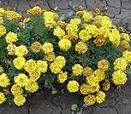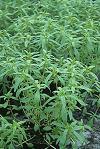|
|
Grow companion plants
When 2 or more plants grow better together than on their own organic gardeners call them companion plants. Growing climbing beans up corn while interplanting pumpkins is a well-known example. The corn supports the beans, the pumpkins smother the weeds and the beans facilitate fixation of nitrogen from air into the soil. The plants are not grown so close that they hinder each other.
Similarly reductions in carrot root fly have been observed while next to growing onions. In greenhouses French marigolds are used to reduce whitefly.
How do companion plants work?

| Tagetes patula
'safari bee'

|
Companions may:-
- produce chemicals that kill pests e.g. french marigolds killing non cyst-forming eelworm.
- produce scent that reduces the ability of pests to find the crop by masking crop scent e.g. growing onions inhibit carrot root fly.
- attract the pest away from the crop. e.g. nasturtiums attract blackfly, redcurrant attract birds away from blackcurrants.
- reduce the chance of pests settling on the crop plant itself.
- be resistant to plant disease and so reduce the number of infections and spread by spores. e.g. lettuce resistant to downy mildew.
- provide food and shelter for natural pest predators.
- reduce weed seedling numbers, by shading or otherwise inhibiting weeds.
- give the crop shelter from winds or shade crop seedlings from hot sun.
- produce nutrients or growth stimulants around the crop. e.g. nitrogen fixing root nodules on beans.
- provide support for climbing plants. e.g. corn and climbing beans.
Correct timing is a critical factor if companions are to benefit your plants as they can.
Here's a list of some plant companionships
|
SUBJECT PLANT
|
GOOD
COMPANION
|
BAD COMPANION
|
| |
BROAD BEANS
|
Brassicas, Carrots, Celery, Potatoes, Summer Savory and herbs
|
Garlic & Onions
|
| |
FRENCH BEANS
|
Celery, Potatoes, Sweet Corn
|
Garlic & Onions
|
| |
CLIMBING BEANS
|
Sweet Corn, Summer Savory
|
Chards, Beetroot
|
| |
BRASSICAS
|
Garlic, Onions, Celery, Dill, Chards, Beetroot, Nasturtiums, Peas, Tomatoes
|
Runner Beans, Strawberries
|
| |
CARROTS
|
Chives, Garlic, Onions, Leeks, Lettuce, Peas, Tomatoes
|
|
| |
SWEET CORN
|
Beans, Potatoes, Peas, Cucumber family
|
|
| |
TOMATOES
|
Parsley, Basil, Carrots, Garlic, Onions,
|
|
|
Much of the information in the above table can be found in the easy to follow Book by Bob Flowerdew: Go Organic! published by Hamlyn.
Companion planting tips
- Ensure every spot is filled up with plants.
- French marigold Tagetes can be used widely as a companion plant. The scent from older varieties is more potent.
- Surround crops with borders of herbs like lavender, 'old man' artemesia and thyme.
- Grow Poached Egg plant Limnanthes douglasii to attract bumble bees. Grow interconnecting ribbons and bridge pathways too.
- Plant sage and nasturtium around your fruit trees and bushes.
- Try growing crops like carrots among your flower beds.
- Mix clover with grass seed especially for rougher grass around fruit.
- Try making chamomile anthemis nobilis lawn edgings, it has a lovely scent.
Just as gardeners have recognised good companion plants they have also recognised plants that do less well together. A few examples of these are given above.

| Summer
Savory |
Warwick Horticultural Research Institute has found a significant reduction of pests on cabbage when grown with non-related companion plants. Try cabbage and French beans together.
But very little scientific work has been done to quantify companion plant affects. Some reports may be due to natural variations in conditions affecting the pests and disease, like climate, soil type etc…
While some observations are useful and well-accepted, others should be treated with extreme caution e.g. horseradish planted with potatoes. It has been suggested that any plant that does not compete with the crop will work as a companion. At the very least the companions distract the pests from the crop and so make them harder to find. You may be interested in
books on companion plants.
Fill spaces and improve the soil -
Find out about green manure here.
© 2004 - The Organic Gardener.Com.
|
Enjoy this page? Please pay it forward. Here's how...
Would you prefer to share this page with others by linking to it?
- Click on the HTML link code below.
- Copy and paste it, adding a note of your own, into your blog, a Web page, forums, a blog comment,
your Facebook account, or anywhere that someone would find this page valuable.
|





